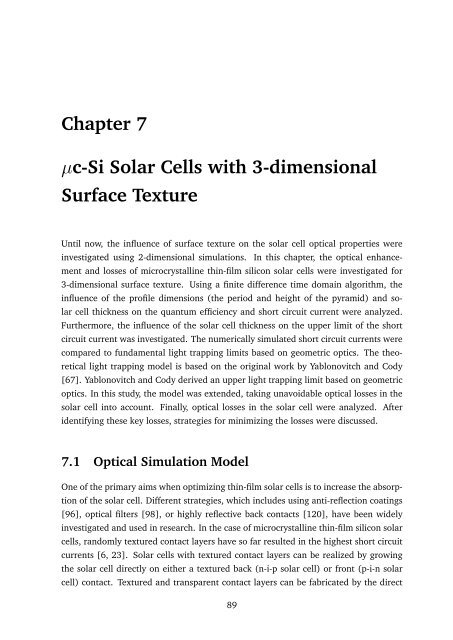Rahul Dewan - Jacobs University
Rahul Dewan - Jacobs University
Rahul Dewan - Jacobs University
Create successful ePaper yourself
Turn your PDF publications into a flip-book with our unique Google optimized e-Paper software.
Chapter 7<br />
µc-Si Solar Cells with 3-dimensional<br />
Surface Texture<br />
Until now, the influence of surface texture on the solar cell optical properties were<br />
investigated using 2-dimensional simulations. In this chapter, the optical enhancement<br />
and losses of microcrystalline thin-film silicon solar cells were investigated for<br />
3-dimensional surface texture. Using a finite difference time domain algorithm, the<br />
influence of the profile dimensions (the period and height of the pyramid) and solar<br />
cell thickness on the quantum efficiency and short circuit current were analyzed.<br />
Furthermore, the influence of the solar cell thickness on the upper limit of the short<br />
circuit current was investigated. The numerically simulated short circuit currents were<br />
compared to fundamental light trapping limits based on geometric optics. The theoretical<br />
light trapping model is based on the original work by Yablonovitch and Cody<br />
[67]. Yablonovitch and Cody derived an upper light trapping limit based on geometric<br />
optics. In this study, the model was extended, taking unavoidable optical losses in the<br />
solar cell into account. Finally, optical losses in the solar cell were analyzed. After<br />
identifying these key losses, strategies for minimizing the losses were discussed.<br />
7.1 Optical Simulation Model<br />
One of the primary aims when optimizing thin-film solar cells is to increase the absorption<br />
of the solar cell. Different strategies, which includes using anti-reflection coatings<br />
[96], optical filters [98], or highly reflective back contacts [120], have been widely<br />
investigated and used in research. In the case of microcrystalline thin-film silicon solar<br />
cells, randomly textured contact layers have so far resulted in the highest short circuit<br />
currents [6, 23]. Solar cells with textured contact layers can be realized by growing<br />
the solar cell directly on either a textured back (n-i-p solar cell) or front (p-i-n solar<br />
cell) contact. Textured and transparent contact layers can be fabricated by the direct<br />
89

















